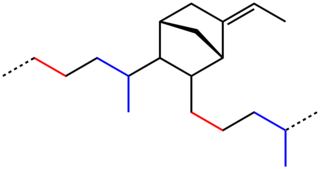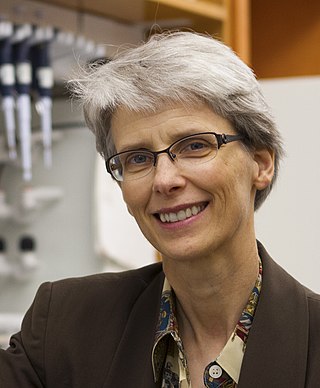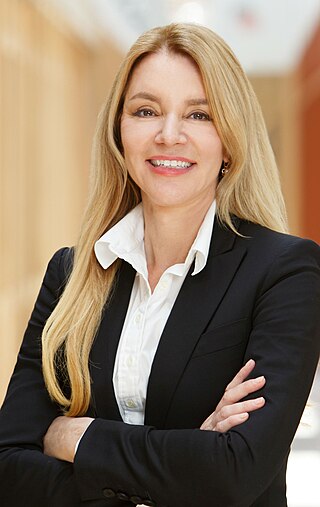
In polymer chemistry, polymerization, or polymerisation, is a process of reacting monomer molecules together in a chemical reaction to form polymer chains or three-dimensional networks. There are many forms of polymerization and different systems exist to categorize them.

EPDM rubber is a type of synthetic rubber that is used in many applications.
In organic chemistry, a polyol is an organic compound containing multiple hydroxyl groups. The term "polyol" can have slightly different meanings depending on whether it is used in food science or polymer chemistry. Polyols containing two, three and four hydroxyl groups are diols, triols, and tetrols, respectively.

Hexafluoroisopropanol, commonly abbreviated HFIP, is the organic compound with the formula (CF3)2CHOH. This fluoroalcohol finds use as solvent in organic chemistry. Hexafluoro-2-propanol is transparent to UV light with high density, low viscosity and low refractive index. It is a colorless, volatile liquid with a pungent odor.

In polymer chemistry, step-growth polymerization refers to a type of polymerization mechanism in which bi-functional or multifunctional monomers react to form first dimers, then trimers, longer oligomers and eventually long chain polymers. Many naturally-occurring and some synthetic polymers are produced by step-growth polymerization, e.g. polyesters, polyamides, polyurethanes, etc. Due to the nature of the polymerization mechanism, a high extent of reaction is required to achieve high molecular weight. The easiest way to visualize the mechanism of a step-growth polymerization is a group of people reaching out to hold their hands to form a human chain—each person has two hands. There also is the possibility to have more than two reactive sites on a monomer: In this case branched polymers production take place.
In polymer chemistry, anionic addition polymerization is a form of chain-growth polymerization or addition polymerization that involves the polymerization of monomers initiated with anions. The type of reaction has many manifestations, but traditionally vinyl monomers are used. Often anionic polymerization involves living polymerizations, which allows control of structure and composition.
Jean M.J. Fréchet is a French-American chemist and professor emeritus at the University of California, Berkeley. He is best known for his work on polymers including polymer-supported chemistry, chemically amplified photoresists, dendrimers, macroporous separation media, and polymers for therapeutics. Ranked among the top 10 chemists in 2021, he has authored nearly 900 scientific paper and 200 patents including 96 US patents. His research areas include organic synthesis and polymer chemistry applied to nanoscience and nanotechnology with emphasis on the design, fundamental understanding, synthesis, and applications of functional macromolecules.
William James Feast is a British chemical scientist and academic.
Functionalized polyolefins are olefin polymers with polar and nonpolar functionalities attached onto the polymer backbone. There has been an increased interest in functionalizing polyolefins due to their increased usage in everyday life. Polyolefins are virtually ubiquitous in everyday life, from consumer food packaging to biomedical applications; therefore, efforts must be made to study catalytic pathways towards the attachment of various functional groups onto polyolefins in order to affect the material's physical properties.

Nancy Allbritton is a Professor of Bioengineering and the Frank & Julie Jungers Dean of the College of Engineering at the University of Washington. She was previously a Kenan Professor and Chair in the Joint Department of Biomedical Engineering at the University of North Carolina at Chapel Hill and North Carolina State University.

Malika Jeffries-EL is an American chemist and professor of chemistry at Boston University studying organic semiconductors. Specifically, her research focuses on developing organic semiconductors that take advantage of the processing power of polymers and the electronic properties of semiconductors to create innovative electronic devices. She was elected as a Fellow of the American Chemical Society in 2018.

Marcey Lynn Waters is the Glen H. Elder Jr., Distinguished Professor of Chemistry at the University of North Carolina, Chapel Hill (UNC-CH). She is an organic chemist whose research is at the interface of chemical biology and supramolecular chemistry. Waters has received multiple awards for research, teaching, and advocating for women in science. She is serving the President of the American Peptide Society (APS) from 2017 to 2019.
Tequila Harris is an American mechanical engineer and professor. She is Professor of Manufacturing at the George W. Woodruff School of Mechanical Engineering. She works on polymer processing and mechanical system design.
Elizabeth Marie Nolan is an American chemist and associate professor at Massachusetts Institute of Technology.
Theresa M. Reineke is an American chemist and Distinguished McKnight University Professor at the University of Minnesota. She designs sustainable, environmentally friendly polymer-based delivery systems for targeted therapeutics. She is the associate editor of ACS Macro Letters.

Eva M. Harth FRSC is a German-American polymer scientist and researcher, and a fellow of both the Royal Society of Chemistry and the American Chemical Society. She is a full professor at the University of Houston and director of the Welch Center for Excellence in Polymer Chemistry.
So-Jung Park 박소정(朴昭靜) is a professor of chemistry at Ewha Womans University, Republic of Korea. Her research considers the self-assembly of nanoparticles and functional molecules for biomedical and optoelectronic devices. She serves as Associate Editor of ACS Applied Materials & Interfaces and Nanoscale.
Jessica R. Kramer is an American biomedical engineer working as an Assistant Professor of Bio-engineering and Adjunct Assistant Professor of Pharmaceutics and Pharmaceutical Chemistry at the University of Utah. Kramer’s research lab focuses on the synthesis and application of glycopolypeptides.
Valerie J. Kuck is an American chemist. She is a Fellow of the American Chemical Society, and she was awarded the Garvan–Olin Medal in 2018 "for pioneering research on coatings for optical fibers and copper wire and for transformative achievements leading to a more diverse and inclusive chemical profession". Madeleine Jacobs, President of the Council of Scientific Society, commented on Kuck's reception of the award that "Valerie’s research led to 25 patents and 26 technical publications published in top peer-reviewed journals. [Her] service to chemistry and to the American Chemical Society is almost without peer".
Rebekka Klausen is an American chemist who is the Second Decade Society Associate Professor at Johns Hopkins University. Her research considers carbon and silicon-based nanomaterials for optoelectronic devices. She was a finalist for the 2021 Blavatnik Awards for Young Scientists.









